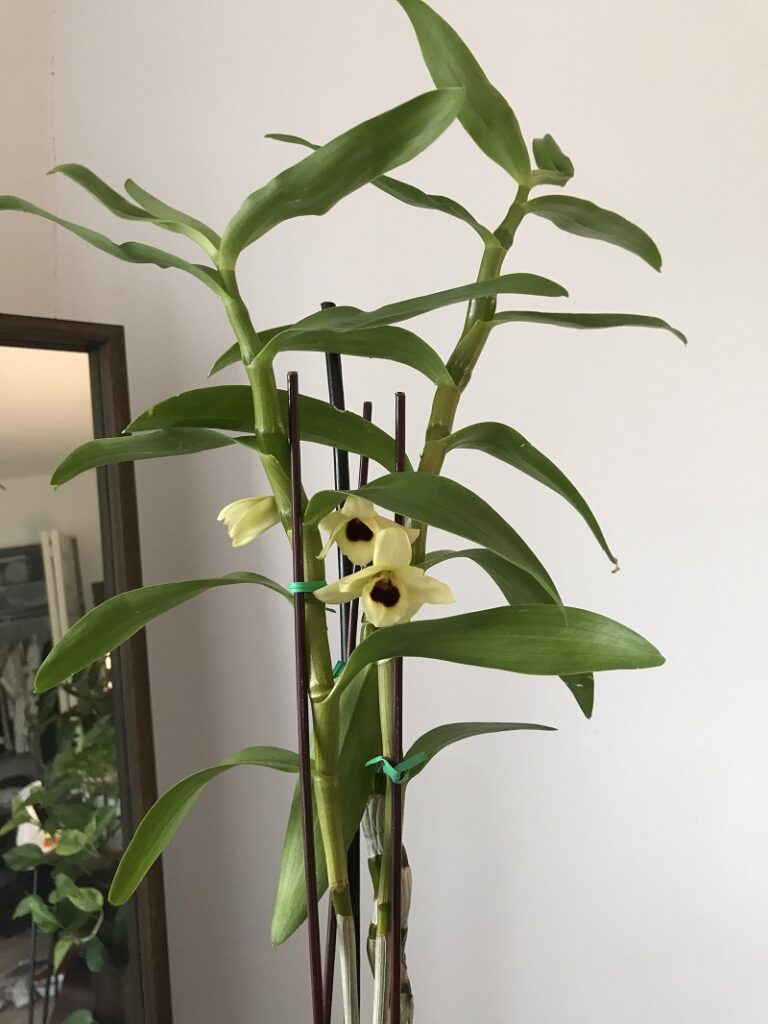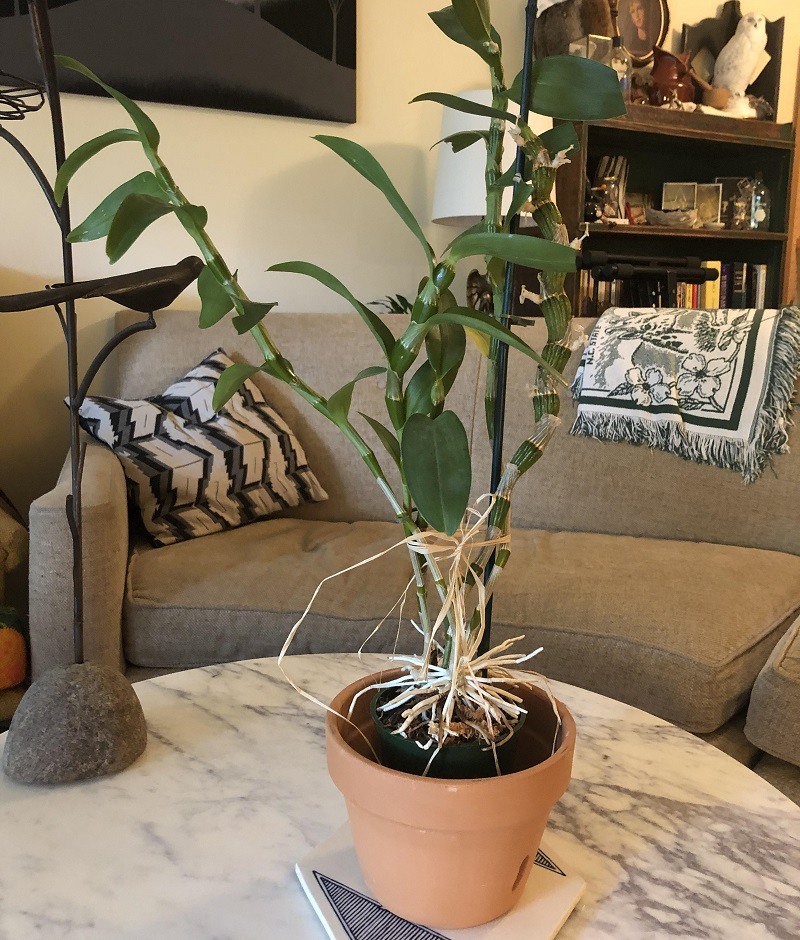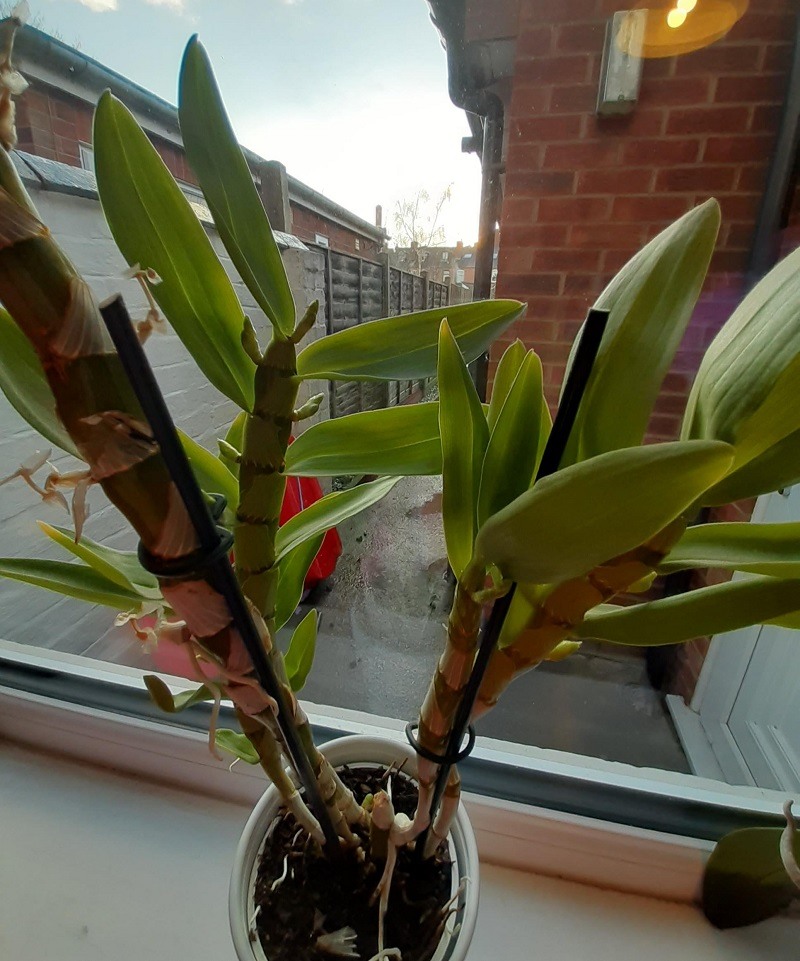Dendrobium Nobile orchid is the most colorful and beautiful species of orchid. One of my favorite features about nobile orchids is the ease to grow and maintain them.
Most orchid species thrive in a warm sunny location to provide striking colors and wonderful scents. This article will walk you through how to grow and care for dendrobium orchids.
How to care for Dendrobium Nobile orchid: Provide bright sunlight, temperature range of 65-85oF (18-30oC), and 50-70% humidity level. Plant in orchid potting mix, water when the topsoil is dry, and apply slow-release fertilizer every early spring. Prune after flowering.
Keep reading to learn other vital tips for growing and caring for Dendrobium Nobile orchids. This step-by-step dendrobium orchid care guide will help you grow a healthy houseplant.
You May Also: Does Bleach Kill Weeds and Grass Permanently

What Does Dendrobium Nobile Orchid Look Like?
Dendrobium Nobile is a flowering plant that belongs to the Orchidaceae family. The stunning colors and fragrances make the orchid species popular in many homes.
The indoor dendrobium orchid plant is native to many countries in Southeast Asia, Indonesia, and Australia. Research shows that there are over 1800 species of orchid dendrobium.
The colorful flowers allow this ornamental houseplant to mark a bold statement in a room during winter and spring. The charming flowers produce delightful aromas in the house.
The dendrobium orchid bloom comes in various shades of pink, white, lilac, rose, and purple. The multicolored flowers are the reason behind their popularity in American homes.
The only drawback about the Dendrobium Nobile orchid is its poisonous properties. The toxicity level is worse after ingestion. Therefore, take care of your pets and toddlers.
Dendrobium orchid care instructions are simple for successful growth. This guide will help you learn how to grow Dendrobium orchids like a professional.
You May Also Read: How to Care for Mother of Thousands
Dendrobium Nobile Orchid Care Details
| Origin | Asia, India, Thailand, Nepal, and China |
| Family | Orchidaceae |
| Scientific Name | Dendrobium Nobile |
| Common Name | Noble Dendrobium |
| Varieties | Dendrobium phalenanthe Dendrobium spatulata Dendrobium latouria Dendrobium Formosae |
| Maximum Growth (Approx.) | 4 feet tall |
| Watering Requirement | Require more water in summer due to active growth. |
| Light Requirement | Bright sunlight throughout the year. |
| Humidity Requirement | The average humidity is about 50-70%. |
| Soil Requirement | Well, drainage and aerated potting soil. |
| Fertilizer Application | Houseplant fertilizer application 1-2 in early spring. |
| Blooming Season | Each dendrobium Nobile cane produces 20-50 blooms in winter and spring. |
| Temperature Requirement | 65-85oF (18-30oC). |
| Pests | Scales, Mites, Thrips, Mealybugs, Whitefly, and fungus gnats. |
| Diseases | Bacterial and fungal diseases. |
How to Care for Dendrobium Nobile Orchid
How to Water Dendrobium Nobile Orchid
One of the most critical dendrobium orchid cares is providing the correct amount of water. But the water requirements for orchid dendrobium vary during the year.
Water the potting soil thoroughly in summer due to the active growth. The dendrobium species tend to use a lot of water to carry out their physiological activities.
Be sure to inspect the potting media moisture content before watering. It is the best way to avoid issues related to under-watering and overwatering.
Another excellent alternative is to monitor the weight of the pot. Dry potting soil is lighter than its watered counterpart. Always provide your dendrobium orchid with sufficient water.
The frequency of watering the houseplant depends on the temperature, ventilation, pot size, and root-bound. These factors will help you know when to water the houseplant.
Always soak the potting media until excess water drains out from the bottom of the pot. I recommend watering your dendrobium nobile in the morning.
To reduce the risk of fungal diseases, consider increasing heat, light, and ventilation. It will help to allow excess water to evaporate.
Most orchid species experience slow growth in winter. You’ll have to reduce the watering routine and monitor any signs of potting soil drying.
I recommend watering dendrobium orchids every 2-3 weeks to encourage bud and bloom development. Increase watering routine once the new buds and bloom have started to develop.
Dendrobium Nobile Orchid Light Requirement
Dendrobium Nobile thrives in bright sunlight without becoming fussy. Keep this orchid species in bright sunlight throughout the year.
Nobile dendrobium can tolerate direct sunlight for an extended period in winter than summer. I recommend exposing the plant to direct sunlight in the early morning for few hours in summer.
Consider placing the houseplant in the south-facing window in winter, spring, and fall. Relocate the plant to the east-facing window in the hot summer to avoid leaf scorch.
Excess sunlight exposure might result in leaves curling and discoloration. Consider changing the current location of your dendrobium nobile to a region with less intense sunlight conditions.
Temperature Requirement for Dendrobium Nobile
Orchid Dendrobium is not sensitive to temperature changes. It can tolerate the indoor temperature dynamics throughout the year without becoming fussy.
But provide an ideal room temperature to experience better growth and encourage the plant to re-bloom year after year. Be sure to provide specific temperature conditions in autumn or fall.
Dendrobium orchids thrive under a temperature range of 65-85oF (18-30oC). The night temperature should not go below 54oF (12oC).
Provide warmer temperatures during blooming and active growth phases (February and September). Provide cooler temperatures in autumn (October to January) to stimulate bud and bloom development.
You May Also Read: How to Care for Macodes Petola
Dendrobium Nobile Humidity Requirement
Nobile dendrobium is the only orchid species that are less sensitive to humidity changes. It can tolerate an average humidity of about 50-70%.
Higher humidity with increased ventilation guarantees stunning flowers and foliages. Adequate ventilation also helps to reduce the risk of fungal diseases.
I recommend growing the orchid dendrobium in your collection to increase the humidity level. Install a digital hygrometer (Check Best Deals on Amazon) to monitor the humidity changes.

Soil Requirement for Dendrobium Nobile Orchid
Dendrobium Nobile orchids are epiphytic plants that attach themselves to other plants rather than in the soil. Be sure to grow the plant in a well-aerated and draining potting medium.
Mix an equal amount of coarse pine bark, coconut husk, and perlite. Choose a potting container with drainage holes at the bottom to get rid of excess water.
The potting soil aeration and drainage holes inhibit overwatering issues. The potting media will allow this epiphytic plant to thrive and bloom every year.
Fertilizing Dendrobium Nobile Orchid
A slow-release diluted fertilizer is ideal for the Dendrobium Nobile orchid plant. It is advisable to apply fertilizer every 1-2 weeks during early spring and summer.
The good news is that dendrobium orchids are not heavy feeders. But they need nutrients and minerals to enhance better growth rate.
Do not apply fertilizer to the orchid species in winter and fall. It is vulnerable to nutrients toxicity and root burn since the plant is dormant. It also stimulates re-blooming and new growths
Dendrobium Nobile Orchid Blooms
Dendrobium Nobile orchids have stunning, delicate, and numerous flowers. A single nobile orchid produces 20-50 blooms with a spectacular display.
These flowers have light and pleasant scents ideal for any indoor space. But this plant usually blooms in early spring and winter (January to March). Bloom lasts for 6-12 weeks.
Re-Blooming Dendrobium Nobile Orchid
Re-blooming orchid dendrobium is a no-brainer task. It would be best to increase the watering rate, apply slow-release fertilizer, and provide an ideal temperature of about 65-85oF (18-30oC).
The introduction of bright sunlight will foster vegetative growth and leaves dropping from already flowered canes. It is normal since dendrobium orchids are semi-deciduous.
Vegetative growth is common from April to August, with the development of several pseudobulbs. These pseudobulbs are likely to be the site where new blooms will take place in winter.
The orchid canes stop developing new leaves as we approach fall. It is also the period to stop fertilizing and reduce the watering rate to stimulate re-blooming.
How to Stake Dendrobium Orchids
Staking dendrobium orchids help to enhance upright posture and prevent the risk of pot toppling due to heavy tops. Most orchid canes grow angle away from the pot.
Be sure to place the stake close to the cane and parallel. Use the clips to loosely attach the canes to the stake to restrict the growth direction of the plant.
Other perfect alternatives are hanging baskets (Check Best Deals on Amazon) and wall mount planters (Check Best Deals on Amazon).
How to Repot Dendrobium Nobile Orchid
Orchid Dendrobium is vulnerable to root-bound issues. I recommend repotting the plant every 2-3 years into a bigger container.
Consider also repot the plant due to reducing potting media drainage and overgrown canes. Be sure to repot once the bloom is over and the plant is about to enter the vegetative growth phase.
Use a fresh potting mix with proper drainage and a bigger container. Ensure the container has drainage holes at the bottom to get rid of excess water.
Divide the canes into three and replant them in different containers. Provide bright sunlight, ideal temperature, and water to enhance faster growth.
Dendrobium Orchid Pruning and Trimming
Trim the flower spikes on the cane once the flowering stage is over. Do not cut individual canes after flowering since they are known for re-blooming in the following year.
These canes also have stored nutrients and energy that enhance the growth of new canes during the vegetative growth phase. The nutrients foster new buds and bloom development.
Cut old canes using a sterilized pruner (Check Best Deals on Amazon) to redirect energy to new growths. Besides that, old canes have exhausted nutrients and energy.

Common Dendrobium Nobile Orchid Problems
Dendrobium Yellow Leaves
Yellow dendrobium orchid occurs after the flowering stage. The deciduous nature allows some leaves to turn yellow, wither, and drop off from the plant.
No need to freak since it is the life cycle of dendrobium nobile plants. If the new leaves are turning yellow, it is a sign of something wrong with your care regime.
Most orchid leaves turning yellow occur due to overwatering or under-watering. Take the time to inspect the potting media to check the moisture content.
Another possible cause of yellow dendrobium orchid is underfeeding. Nitrogen deficiency in the potting media is the reason behind the leaf discoloration. Apply fertilizer to enhance vegetative growth.
Pest infestations and diseases are other potential causes of Dendrobium Nobile orchid leave turning yellow. Examine the leaves for any sign of pests or disease and consider treating. Use insecticidal soap (Check the Best Deals on Amazon) to eradicate the pests.
Dendrobium Drying Out
Drying and shriveling of the canes occur due to insufficient watering. The condition makes the leaves crunchy and brown.
Dendrobium Nobile is the only orchid species that can tolerate more water without developing root rot. Inspect the potting media moisture content and soak it with water.
Dendrobium Orchid Wilting
Improper watering routine is the main cause of wilting among white dendrobium orchids. Dehydrate canes fall over and die in the long run. Schedule a strict watering regime to avoid under-watering and overwatering issues.
Dendrobium Nobile Pests
Dendrobium orchid white is less vulnerable to pest infestations. But this does not imply that the houseplant is invincible to insect infestations.
The common sap-sucking insects that attack dendrobium orchids are spider mites, aphids, thrips, scales, and mealybugs. Use insecticidal soap to get rid of these creatures from the plant.
Dendrobium Orchid Diseases
The improper growing condition increases the risk of fungal and bacterial diseases among Dendrobium Nobile orchids. Overwatering is the leading cause of fungal and bacterial diseases.
Treating both bacterial and fungal diseases in orchid dendrobium is a nightmare. I recommend considering preventative measures rather than treating them.
Is Dendrobium Nobile Orchid Plant Toxic?
Dendrobium Nobile orchid has poisonous properties. Don’t allow your pets or toddlers to ingest the raw plant since it will result in serious problems.
But the flowers and canes can be dried then steeped in hot water to create tea. The dendrobium blooms are popular in Asian cuisine.
Final Word
Dendrobium Nobile orchid is ideal for houseplant enthusiasts looking for something easy to grow and care for. The ease of maintenance makes this indoor plant suitable for beginners.
Orchid Dendrobium is less vulnerable to diseases and pests. It can also tolerate harsh growing conditions without becoming fussy for a couple of weeks.
Take the time to read this guide to learn how to grow and care for orchid Dendrobium Nobile like a professional. These steps have been tested and proven to be quite effective.
